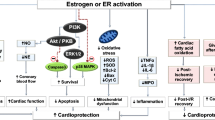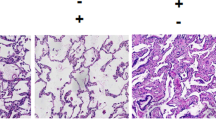Abstract
We explored the sex difference in lung ischemia–reperfusion injury (LIRI) and the role and mechanism of estrogen (E2) and angiotensin II (Ang II) in LIRI. We established a model of LIRI in mice. E2, Ang II, E2 inhibitor (fulvestrant), and angiotensin II receptor blocker (losartan) were grouped for treatment. The lung wet/dry weight ratio, natural killer (NK) cells (by flow cytometry), neutrophils (by flow cytometry), expression of key proteins (by Western blot, immunohistochemistry, ELISA, and immunofluorescence), and expression of related protein mRNA (by qPCR) were detected. The ultrastructure of the alveolar epithelial cells was observed by transmission electron microscopy. We found that E2 and Ang II played an important role in the progression of LIRI. The two signaling pathways showed obvious antagonism, and E2 regulates LIRI in the different sexes by downregulating Ang II, leading to a better prognosis. E2 and losartan reduced the inflammatory cell infiltration in lung tissue and key inflammatory factors in serum while fulvestrant and Ang II had the opposite effect. The protective effect of E2 was related with AKT, p38, COX2, and HIF-1α.






Similar content being viewed by others
Data Availability
No datasets were generated or analyzed during the current study.
References
Gorman, E.A., C.M. O’Kane, and D.F. McAuley. 2022. Acute respiratory distress syndrome 2022 2 Acute respiratory distress syndrome in adults: Diagnosis, outcomes, long-term sequelae, and management. Lancet 400: 1157–1170.
Eltzschig, H.K., and T. Eckle. 2011. Ischemia and reperfusion-from mechanism to translation. Nature Medicine 17: 1391–1401.
Ferrari, R.S., and C.F. Andrade. 2015. Oxidative stress and lung ischemia-reperfusion injury. Oxidative Medicine and Cellular Longevity 2015.
Moss, M., and D.M. Mannino. 2002. Race and gender differences in acute respiratory distress syndrome deaths in the United States: An analysis of multiple-cause mortality data (1979–1996). Critical Care Medicine 30: 1679–1685.
Erfinanda, L., K. Ravindran, F. Kohse, K. Gallo, R. Preissner, T. Walther, and W.M. Kuebler. 2021. Oestrogen-mediated upregulation of the Mas receptor contributes to sex differences in acute lung injury and lung vascular barrier regulation. European Respiratory Journal 57.
Wang, J., J.R. Li, A.N. Lou, Y. Lin, Q.H. Xu, W.F. Cui, W.C. Huang, G.Z. Wang, Y. Li, J. Sun, et al. 2023. Sacubitril/valsartan alleviates sepsis-induced acute lung injury via inhibiting GSDMD-dependent macrophage pyroptosis in mice. Febs Journal 290: 2180–2198.
Ye, R.S., and Z.W. Liu. 2020. ACE2 exhibits protective effects against LPS-induced acute lung injury in mice by inhibiting the LPS-TLR4 pathway. Experimental and Molecular Pathology 113.
Lawler, P.R., L.P.G. Derde, B.J. McVerry, J.A. Russell, and F.L. van de Veerdonk. 2022. The renin-angiotensin system in acute lung injury. Critical Care Medicine 50: 1411–1415.
Chanana, N., T. Palmo, K. Sharma, R. Kumar, B.B. Graham, and Q. Pasha. 2020. Sex-derived attributes contributing to SARS-CoV-2 mortality. American Journal of Physiology-Endocrinology and Metabolism 319: E562–E567.
Murakami, S., E.A. Bacha, G.M. Mazmanian, H. Detruit, A. Chapelier, P. Dartevelle, and P. Herve. 1997. Effects of various timings and concentrations of inhaled nitric oxide in lung ischemia-reperfusion. American Journal of Respiratory and Critical Care Medicine 156: 454–458.
Tomaszewski, W.H., J. Waibl-Polania, A.M. Miggelbrink, M.A. Chakraborty, P.E. Fecci, J.H. Sampson, and M.D. Gunn. 2021. Broad immunophenotyping of the murine brain tumor microenvironment. Journal of Immunological Methods 499.
Tang, H.X., Y.D. Liao, L.Q. Xu, C. Zhang, Z.G. Liu, Y. Deng, Z.X. Jiang, S.L. Fu, Z.G. Chen, and S. Zhou. 2013. Estrogen and insulin-like growth factor 1 synergistically promote the development of lung adenocarcinoma in mice. International Journal of Cancer 133: 2473–2482.
Prakash, A., K.R. Mesa, K. Wilhelmsen, F.X. Xu, J.M. Dodd-o, and J. Hellman. 2012. Alveolar macrophages and Toll-like receptor 4 mediate ventilated lung ischemia reperfusion injury in mice. Anesthesiology 117: 822–835.
Li, W.J., D. Li, L.K. Sun, Z.Y. Li, L. Yu, and S.L. Wu. 2018. The protective effects of estrogen on hepatic ischemia-reperfusion injury in rats by downregulating the Ang II/AT1R pathway. Biochemical and Biophysical Research Communications 503: 2543–2548.
Chen, J.G., S.L. Yang, S.H. Hu, M.A. Choudhry, K.I. Bland, and I.H. Chaudry. 2008. Estrogen prevents intestinal inflammation after trauma-hemorrhage via downregulation of angiotensin II and angiotensin II subtype I receptor. American Journal of Physiology-Gastrointestinal and Liver Physiology 295: G1131-G1137.
Nowak, K., M. Kamler, M. Bock, J. Motsch, S. Hagl, H. Jakob, and M.M. Gebhard. 2002. Bronchial artery revascularization affects graft recovery after lung transplantation. American Journal of Respiratory and Critical Care Medicine 165: 216–220.
Wang, L.F., Y.Y. Sun, Q. Pan, Y.Q. Yin, X.M. Tian, Y. Liu, T.G.L.Q. Bu, Q.Y. Zhang, Y.A. Wang, J. Zhao, and Y. Luo. 2021. Diminazen aceturate protects pulmonary ischemia-reperfusion injury via inhibition of ADAM17-mediated angiotensin-converting enzyme 2 shedding. Frontiers in Pharmacology 12.
Vivier, E., D.H. Raulet, A. Moretta, M.A. Caligiuri, L. Zitvogel, L.L. Lanier, W.M. Yokoyama, S. Ugolini. 2011. Innate or adaptive immunity? The example of natural killer cells. Science 331.
Raulet, D.H., S. Gasser, B.G. Gowen, W.W. Deng, and H.Y. Jung. 2013. Regulation of ligands for the NKG2D activating receptor. Annual Review of Immunology 31 (31): 413–441.
Victorino, F., D.K. Sojka, K.S. Brodsky, E.N. McNamee, J.C. Masterson, D. Homann, W.M. Yokoyama, H.K. Eltzschig, and E.T. Clambey. 2015. Tissue-resident NK cells mediate ischemic kidney injury and are not depleted by anti-asialo-GM1 antibody. Journal of Immunology 195: 4973–4985.
Zingoni, A., C. Fionda, C. Borrelli, M. Cippitellii, A. Santoni, and A. Soriani. 2017. Natural killer cell response to chemotherapy-stressed cancer cells: role in tumor immunosurveillance. Frontiers in Immunology 8.
Somers, J., D. Ruttens, S.E. Verleden, E. Vandermeulen, D. Piloni, E. Wauters, D. Lambrechts, R. Vos, G.M. Verleden, B. Vanaudenaerde, and D.E. van Raemdonck. 2015. Interleukin-17 receptor polymorphism predisposes to primary graft dysfunction after lung transplantation. Journal of Heart and Lung Transplantation 34: 941–949.
Gazoni, L.M., C.G. Tribble, M.Q. Zhao, E.B. Unger, R.A. Farrar, P.I. Ellman, L.G. Fernandez, V.E. Laubach, and I.L. Kron. 2007. Pulmonary macrophage inhibition and inhaled nitric oxide attenuate lung ischemia-reperfusion injury. Annals of Thoracic Surgery 84: 247–253.
Fiser, S.M., C.G. Tribble, S.M. Long, A.K. Kaza, J.T. Cope, V.E. Laubach, J.A. Kern, and I.L. Kron. 2001. Lung transplant reperfusion injury involves pulmonary macrophages and circulating leukocytes in a biphasic response. Journal of Thoracic and Cardiovascular Surgery 121: 1069–1075.
Zhao, M.Q., L.G. Fernandez, A. Doctor, A.K. Sharma, A. Zarbock, C.G. Tribble, I.L. Kron, and V.E. Laubach. 2006. Alveolar macrophage activation is a key initiation signal for acute lung ischemia-reperfusion injury. American Journal of Physiology-Lung Cellular and Molecular Physiology 291: L1018–L1026.
Yang, Z.Q., A.K. Sharma, J. Linden, I.L. Kron, and V.E. Laubach. 2009. CD4+ T lymphocytes mediate acute pulmonary ischemia-reperfusion injury. Journal of Thoracic and Cardiovascular Surgery 137: 695–702.
Rathod, K.S., V. Kapil, S. Velmurugan, R.S. Khambata, U. Siddique, S. Khan, S. Van Eijl, L.C. Gee, J. Bansal, K. Pitrola, et al. 2017. Accelerated resolution of inflammation underlies sex differences in inflammatory responses in humans. Journal of Clinical Investigation 127: 169–182.
Hammes, S.R., and E.R. Levin. 2007. Extranuclear steroid receptors: Nature and actions. Endocrine Reviews 28: 726–741.
Pedram, A., M. Razandi, R.J. Deschenes, and E.R. Levin. 2012. DHHC-7 and-21 are palmitoylacyltransferases for sex steroid receptors. Molecular Biology of the Cell 23: 188–199.
Zhao, L.Z., and R.D. Brinton. 2007. Estrogen receptor α and β differentially regulate intracellular (Ca2+) dynamics leading to ERK phosphorylation and estrogen neuroprotection in hippocampal neurons. Brain Research 1172: 48–59.
Fels, J.A., and G. Manfredi. 2019. Sex differences in ischemia/reperfusion injury: The role of mitochondrial permeability transition. Neurochemical Research 44: 2336–2345.
Halestrap, A.P., and A.P. Richardson. 2015. The mitochondrial permeability transition: A current perspective on its identity and role in ischaemia/reperfusion injury. Journal of Molecular and Cellular Cardiology 78: 129–141.
Parton, R.G., K.A. Mcmahon, and Y.P. Wu. 2020. Caveolae: Formation, dynamics, and function. Current Opinion in Cell Biology 65: 8–16.
Foster, C.R., S. Satomi, Y. Kato, and H.H. Patel. 2020. The caveolar-mitochondrial interface: Regulation of cellular metabolism in physiology and pathophysiology. Biochemical Society Transactions 48: 165–177.
Yan, F.R., L.L. Su, X.Y. Chen, X.D. Wang, H.Z. Gao, and Y.M. Zeng. 2020. Molecular regulation and clinical significance of caveolin-1 methylation in chronic lung diseases. Clinical and Translational Medicine 10: 151–160.
Lannes-Costa, P.S., B.A.D. Pimentel, P.E. Nagao. 2022. Role of caveolin-1 in sepsis - a mini-review. Frontiers in Immunology 13.
Schönle, A., F.A. Hartl, J. Mentzel, T. Nöltner, K.S. Rauch, A. Prestipino, S.A. Wohlfeil, P. Apostolova, A.K. Hechinger, W. Melchinger, et al. 2016. Caveolin-1 regulates TCR signal strength and regulatory T-cell differentiation into alloreactive T cells. Blood 127: 1930–1939.
Ozturk, S., P. Papageorgis, C.K. Wong, A.W. Lambert, H.M. Abdolmaleky, A. Thiagalingam, H.T. Cohen, and S. Thiagalingam. 2016. SDPR functions as a metastasis suppressor in breast cancer by promoting apoptosis. Proceedings of the National Academy of Sciences of the United States of America 113: 638–643.
Acknowledgements
We thank all our colleagues who helped us during the current study. We greatly appreciate the kind assistance of Doctors in the Department of Thoracic Surgery, Zhongnan Hospital of Wuhan University, for the assistance in discussing the key issues of this study.
Funding
This project was supported by the Natural Science Foundation of Hubei Province [2020CFB703].
Author information
Authors and Affiliations
Contributions
Peng Dai, Jutong He, Yanhong Wei, and Hexiao Tang conceived and designed the study. Peng Dai and Jutong He contributed to the literature search, animal experiment, and data collection. Peng Dai and Xuefeng Zhou contributed to the data analysis. Xuefeng Zhou, Ming Xu, Jinping Zhao, and Hexiao Tang contributed to data interpretation. Peng Dai, Xuefeng Zhou, Jinping Zhao, and Hexiao Tang contributed to write and revise the report. Jinping Zhao and Hexiao Tang contributed to the figures of the report. All authors read and approved the final manuscript.
Corresponding authors
Ethics declarations
Ethics Approval
This experiment was approved by the Animal Ethics Committee of Zhongnan Hospital of Wuhan University (Approval No ZN2022115). We confirm that all experiments were performed in accordance with the Laboratory Animal-Guideline for ethical review of animal welfare. We confirm that the authors complied with the ARRIVE guidelines.
Competing Interests
The authors declare no competing interests.
Additional information
Publisher's Note
Springer Nature remains neutral with regard to jurisdictional claims in published maps and institutional affiliations.
Peng Dai, Jutong He, and Yanhong Wei are co-first authors.
Supplementary Information
Below is the link to the electronic supplementary material.
Rights and permissions
Springer Nature or its licensor (e.g. a society or other partner) holds exclusive rights to this article under a publishing agreement with the author(s) or other rightsholder(s); author self-archiving of the accepted manuscript version of this article is solely governed by the terms of such publishing agreement and applicable law.
About this article
Cite this article
Dai, P., He, J., Wei, Y. et al. High Dose of Estrogen Protects the Lungs from Ischemia–Reperfusion Injury by Downregulating the Angiotensin II Signaling Pathway. Inflammation (2024). https://doi.org/10.1007/s10753-024-01973-z
Received:
Revised:
Accepted:
Published:
DOI: https://doi.org/10.1007/s10753-024-01973-z




